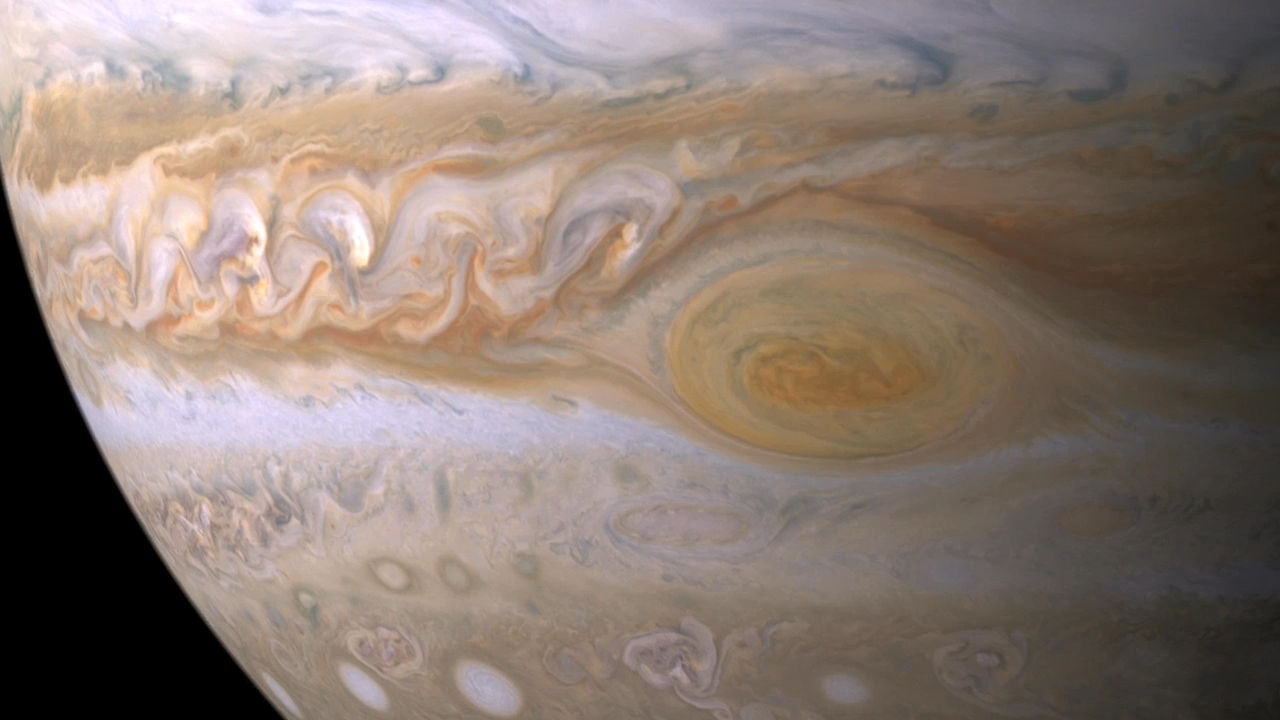Jupiter's Great Red Spot May Yield Its Colorful Secret in a Lab

NASA scientists are trying to find what makes Jupiter's Great Red Spot red — by whipping it up in the lab.
Despite more than 150 years of study, the Great Red Spot on Jupiter remains a mystery. The mammoth storm, twice as wide as Earth, swirls across the face of the largest planet in the solar system with winds peaking at about 400 miles (644 kilometers) per hour. Yet what could be causing the storm remains unknown.
In an attempt to probe the mysteries of the enormous storm, Mark Loeffler and Reggie Hudson, of NASA's Goddard Space Flight Center in Greenbelt, Maryland, are baking some of the components of Jupiter's atmosphere with radiation, mimicking cosmic rays, to determine if they can be altered to produce the reddish color of the Spot. [Photos of Jupiter's Great Red Spot]
Observing Jupiter's atmosphere to determine the source of the storm's red color is a challenge. The planet's cloud layer make clear observations of the lower atmosphere difficult, and only slightly more is known about its upper atmosphere. Studies predict that Jupiter's upper atmosphere is composed of clouds of ammonia, ammonium hydrosulfide and water, which scientists suspect could be a source for the Spot. But scientists don't know if those chemical components, which make up only a small part of the atmosphere, could mix together to form the colors that make the storm so distinctive, much less how they might combine.
"We're talking about something that only makes up a really tiny portion of the atmosphere," planetary atmosphere expert Amy Simon, also of Goddard, said in a statement. "That's what makes it so hard to figure out exactly what makes the colors that we see."
Ammonium hydrosulfide is unstable when subjected to Earth's atmospheric conditions, so Loeffler heats up hydrogen sulfide and ammonia to create his own. Charged particles then assault the concoction, much as cosmic rays blast Jupiter's clouds. The researchers have identified the products of irradiating the colorless mixture, and their challenge now is to see if any of them have the precise reddish shade of Jupiter's storm.
"That's the problem," Simon said. "Is it turning the right color red?"
Breaking space news, the latest updates on rocket launches, skywatching events and more!
While ammonium sulfide could be a cause, the coloring could also come from multiple factors in Jupiter's atmosphere interacting.
"Ideally, what you'd want is a mixture with the right components of everything you see in Jupiter's atmosphere at the right temperature, and then irradiate it at the right levels," Simon said. Exactly replicating the conditions on Jupiter's surface is the key: "What we are trying to do is design lab experiments more realistic to Jupiter's atmosphere," Simon said. [Inside Gas Giant Jupiter (Infographic)]
The massive storm has been studied for more than 150 years. Possibly much more: While astronomers from the 1600s identified a similar feature on Jupiter, it is uncertain if it is the same Great Red Spot. Either way, the squall has endured far longer than any storm on Earth.
Unlike Earth, Jupiter is a gas giant, with a liquid ocean of hydrogen around its core and an atmosphere dominated by hydrogen and helium. No solid ground exists for the storm to blow itself out over, allowing the Great Red Spot to last for more than a century.
Studying the long-lasting storm can help scientists better understand the weather system on Earth, Simon said. After all, the weather on both planets function under the same laws of physics. She also said that studying Jupiter can improve understanding of planets outside of the solar system.
"If you just look at reflected light from an extrasolar planet, you're not going to be able to tell what it's made of," Simon said. "Looking at as many possible different cases in our solar system could enable us to then apply that knowledge to extrasolar planets."
Follow Nola Taylor Redd on Twitter @NolaTRedd. Follow us @Spacedotcom, Facebook or Google+. Originally published on Space.com.

Nola Taylor Tillman is a contributing writer for Space.com. She loves all things space and astronomy-related, and always wants to learn more. She has a Bachelor's degree in English and Astrophysics from Agnes Scott College and served as an intern at Sky & Telescope magazine. She loves to speak to groups on astronomy-related subjects. She lives with her husband in Atlanta, Georgia. Follow her on Bluesky at @astrowriter.social.bluesky
